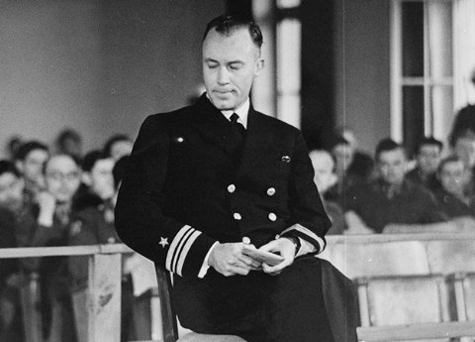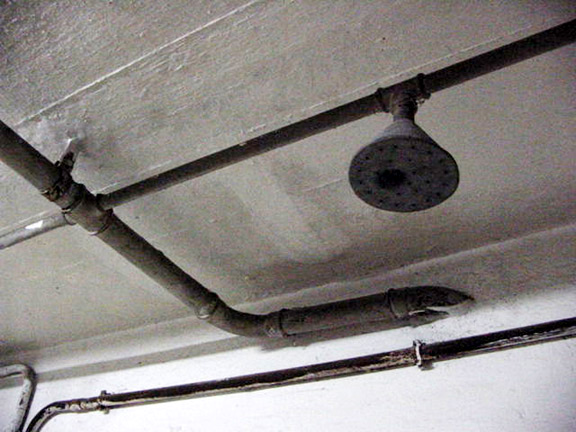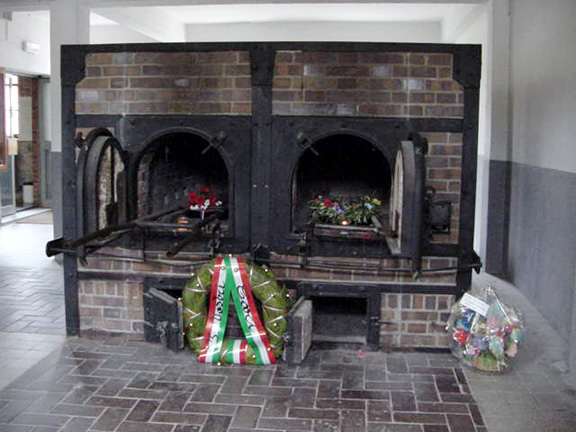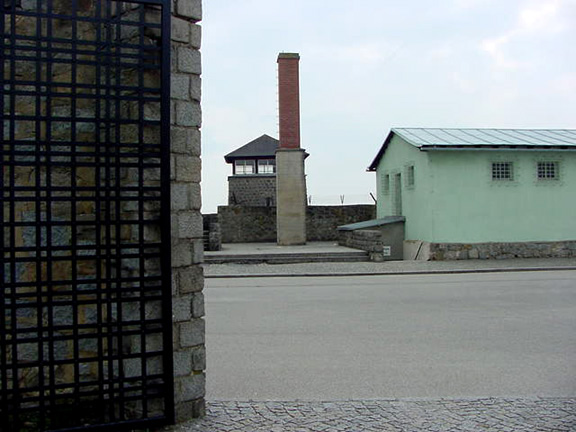Dachau TrialsUS. vs. Hans Altfuldisch, et alPreviousMauthausen concentration camp, a Class III camp in Austria for "Return Unwanted" prisoners, was liberated on May 5, 1945; it was the last of the Nazi camps to be liberated by American troops, just three days before World War II ended on May 8, 1945. The American soldiers were greeted by 37-year-old Lt. Jack H. Taylor, a Commando in the United States Navy, who had been captured after leading a sabotage mission behind enemy lines. Lt. Taylor had been a prisoner at Mauthausen for only 35 days; he had arrived in the camp on April 1, 1945, after being transferred from a Gestapo prison in Vienna because Soviet troops were 50 kilometers from the city and advancing rapidly.  The photograph above shows Lt. Jack Taylor, taken shortly after his liberation from Mauthausen. On his jacket, Lt. Taylor was required to wear a red triangle, pointing downward, which meant that he was classified as a non-German political prisoner. Because he was fighting with a group of partisans, Lt. Jack Taylor was an illegal combatant under the Geneva Convention of 1929, and was not entitled to the rights of a Prisoner of War. Lt. Taylor was imprisoned at the main camp at Mauthausen, but the mountains in the background indicate that this photo was taken at one of the sub-camps of Mauthausen. Only hours after the liberation of the Mauthausen camp, Lt. Col. George C. Stevens, the famed Hollywood director, arrived to shoot some footage of Lt. Taylor for his film entitled "Nazi Concentration Camps," which was shown at the Nuremberg International Military Tribunal on November 29, 1945. Lt. Taylor was a former dentist from Hollywood, California and he started off by saying that this was the first time he had ever been in a movie. According to Lt. Taylor's debriefing statement, there were two other American men at Mauthausen and two British citizens, one a pilot and one a spy in the SOE, when the camp was liberated, but none of them testified at Nuremberg or Dachau. Lt. Taylor was the only American ever to testify for the prosecution in the Dachau trials and his testimony was considered to be more credible than that of the other former prisoners who might have been seeking revenge, more than justice. After he was liberated from Mauthausen, Jack Taylor was promoted to Lt. Commander and he stayed in Europe to testify in the war crimes trials. The photo below shows Lt. Cmdr. Jack H. Taylor on the witness stand at Dachau, looking much the same as he did in the photo taken after he was liberated from Mauthausen.  Lt. Cmdr. Taylor was a key witness at the Trial of the 61 accused men from the Mauthausen concentration camp. The prosecution had only to prove that there was a "common design" to commit war crimes at Mauthausen and that each of the accused had participated in that plan because he was associated with the camp in some capacity. Taylor's testimony proved that there was a "common design" and all 61 of the accused were convicted. Prior to the proceedings at Dachau in the Mauthausen case, Lt. Cmdr. Jack Taylor had given the following testimony at the Nuremberg International Military Tribunal: "In October '44, I was the first Allied officer to drop onto Austria. I was captured December 1st, by the Gestapo, severely beaten, ah, even though I was in uniform, severely beaten, and, and, considered as a non-prisoner of war. I was taken to Vienna prison where I was held for four months. When the Russians neared Vienna, I was taken to this Mauthausen concentration lager [camp], an extermination camp, the worst in Germany, where we have been starving and, and beaten and killed, ah, fortunately, my turn hadn't come. Ah, two American officers at least have been executed here. Here is the insignia of one, a U.S. naval officer, and here is his dog tag. Here is the army officer, executed by gas in this lager [camp]. Ah...there were... [Question: "How many ways did they execute them?"] Five or six ways: by gas, by shooting, by beating, that is beating with clubs, ah, by exposure, that is standing out in the snow, naked, for 48 hours and having cold water put on them, thrown on them in the middle of winter, starvation, dogs, and pushing over a hundred-foot cliff." After only 35 days in the notorious Mauthausen camp, Jack Taylor knew all about the crimes committed there: torture, hangings, shootings, beatings, and the execution of an unnamed American army officer in the gas chamber. A Special Finding, made by the president of the court, Maj. Gen. Fay B. Prickett, declared that there was enough evidence of death by shootings, gassings, hangings and starvation to find every member of the Mauthausen camp personnel guilty of war crimes, including Kapos, who were prisoners that had authority over other prisoners. This Special Finding in the main Mauthausen proceeding was later used to establish guilt in subsequent proceedings against the staff and Kapos at Mauthausen. The "evidence" presented at the Mauthausen trial was mainly hearsay testimony by witnesses such as Jack Taylor. The photograph below shows the "hundred-foot cliff" where SS soldiers at Mauthausen allegedly forced Dutch Jews to leap from a ledge into the quarry. The narrow ledge is in the center of the photo, a short distance from the top of the quarry. Notice the pool of water below the cliff.  Lt. Cmdr. Taylor was the first witness for the prosecution in the Mauthausen case, which was brought before an American Military Tribunal at Dachau. By now, he was an experienced prosecution witness and he elaborated on his Nuremberg testimony. When asked by prosecutor Lt. Col. William Denson, on direct examination, how many different forms of killing that he had come in contact with in Mauthausen, Taylor testified as follows: Gassing, hanging, shooting, beating. There was one particular group of Dutch Jews who were beaten until they jumped over the cliff into the stone quarry. Some that were not killed on the first fall were taken back up and thrown over to be sure. Then there was exposure. Any new transport coming in was forced to stand out in the open, regardless of the time of the year, practically naked. Other forms of killing included clubbing to death with axes or hammers and so forth, tearing to pieces by dogs specially trained for the purpose, injections into the heart and veins with magnesium chloride or benzene, whippings with a cow-tail to tear the flesh away, mashing in a concrete mixer, forcing them to drink a great quantity of water and jumping on the stomach while the prisoner was lying on his back, freezing half-naked in subzero temperatures, buried alive, red-hot poker down the throat. I remember a very prominent Czech general who was held down in the shower room and had a hose forced down his throat. He drowned that way. Of course, Jack Taylor had never seen anyone carried back up to the top of a cliff and thrown off a second time, nor had he ever seen anyone mashed in a concrete mixer, nor buried alive, nor killed with a red-hot poker shoved down his throat. These were stories that he had heard from the other prisoners. This kind of hearsay testimony was common in all the Dachau proceedings. The purpose of reiterating these stories in sworn testimony on the witness stand was to get these atrocities entered into the record, so that these alleged crimes would go down in history for future generations to read as the gospel truth. Lt. Cmdr. Taylor may have been confused about the nationality of the general. There were similar stories about a Russian general, Lt. Gen. Dmitry Mikhailovich Karbyshev, who was either drowned in the shower or forced to stand outside in freezing weather while water was poured over him on some unknown date in February 1945. A statue of Karbyshev encased in a block of ice stands near the gate into the Mauthausen camp. Taylor could not have "remembered" this incident because it had allegedly happened almost two months before he arrived at the camp. The stories about dying from exposure were based on the fact that the prisoners had to take a shower and then stand naked outside while their clothes and barracks were disinfected in an effort to prevent typhus which is spread by body lice. Under cross examination, the defense attorney established that Lt. Cmdr. Taylor had only seen "maybe five or six" of the 61 accused men while he was at Mauthausen, and that Taylor could not say for certain whether any of the accused had committed any of these alleged atrocities while he was at Mauthausen. That didn't matter since, under the common design charge, anyone who was a member of the camp staff where any crime was committed was guilty of that crime, even if he was not on the staff at the time of the crime. Hearsay evidence was allowed by the tribunal, so it didn't matter if Taylor had personally seen any of these alleged atrocities committed. It was enough that he had heard these stories from other inmates, who were not present in the courtroom and thus could not be cross-examined. Lt. Comdr. Taylor testified during the trial that he had been scheduled to die in the Mauthausen gas chamber on May 6, 1945, but he was miraculously saved when American troops arrived the day before his planned execution. In his debriefing statement, Jack Taylor told Dr. Stransky Milos, the Czech prisoner who wrote the statement, the following: After the Americans had liberated us, I discovered that I should have been executed on 28 April 1945, along with 27 other prisoners from Block 13. A friendly Czech, Mylos [Milos], who worked in the political department had, unknown to me, removed my paper and destroyed it so that I was not included with the 27. According to an addendum to the debriefing statement, written by Dr. Stransky Milos, an order was given to execute 27 prisoners who had been sent to Mauthausen on January 4, 1945. Lt. Jack Taylor, who had arrived on April 1, 1945, was included in this order. Dr. Milos wrote the following in his addendum to the debriefing statement: Execution ordered by Kommandeur der Sicherheitspolizei und des Sicherheitsdiestes in Wien based on martial law for 27 police-prisoners, many of the transport from 1.4.1945 took place on 28.4.1945 at Mauthausen afternoon. The execution of the Captain Taylor has not been carried out, because 3 days before I burnt his documents. Keep in mind that the Germans were building Messerschmitt ME262 jet airplanes at Mauthausen and V-2 rockets at a sub-camp of Buchenwald, but they were allegedly too stupid to notice that the only copy of an execution order had been burned by an inmate. In his direct testimony, Taylor was asked by prosecutor Lt. Col. William Denson to describe the gas chamber. As quoted by Joshua M. Greene in "Justice at Dachau," Taylor testified as follows: Yes, sir. It was rigged up like a shower room with shower nozzles in the ceiling. New prisoners thought they were going in to have their bath. They were stripped and put in this room naked. Then gas came out of the shower nozzles. The photo below, taken in May 2003, shows one of the shower nozzles, and water pipes coming through the wall into the Mauthausen gas chamber. The gas chamber was cleverly disguised as a real shower room with real water pipes, real shower heads and real floor drains. However, Jack Taylor was wrong about the gas coming through the shower heads. The gas was in the form of pellets, about the size of peas, which were usually heated so that the poisonous gas fumes would be released faster.  According to the testimony of another Mauthausen prisoner, the poison gas flowed through a tube placed low on the wall of the shower room. In his book entitled "The 186 Steps," Christian Bernadac quoted the testimony of Werner Reinsdorf, a prisoner who came to Mauthausen in 1941 and was assigned Prison Number 535 which had previously been assigned to another man who died. Reinsdorf "took part in the construction of the gas chamber," according to Bernadac. The following quote from Bernadac's book is the words of Werner Reinsdorf: There was a tube that led into the gas chamber, eighty centimeters above the floor, with its opening turned toward the wall so as to escape notice. The gas flowed through this tube...I, myself, saw Jews being led to the gas chamber.... According to stories told by former inmates at Mauthausen, there was a small metal box, near the floor on the other side of one of the shower room walls. An open can of Zyklon-B gas pellets was put into this box, along with a hot brick which heated the pellets to the proper temperature so that prussic acid could be released. An enameled tube, through which the gas flowed, led from the box into the shower room. Unknown to Lt. Taylor, who expected to be gassed on May 6, 1945, Commandant Franz Ziereis had allegedly removed the box and the tube just before he escaped from the camp on the night of May 2, 1945. The tile in the shower room was replaced, and the wall, where the box had been located, was so skillfully repaired that no evidence of how the gas entered the room can be seen today. The photograph below shows a glass case in the Museum at Mauthausen in which an open can of Zyklon-B pellets is displayed. The Museum displays are in the basement of the former hospital building where the gas chamber is located. This type of poison gas was also used in all the concentration camps to disinfect the clothing by killing the body lice which spreads typhus.  After Lt. Jack Taylor arrived at the Mauthausen camp on April 1, 1945, he was put to work "setting tile in the new crematorium," according to his trial testimony. He testified that the camp administrators "were very anxious to have it completed because all the bodies from hanging and beating had to be cremated to destroy the evidence." Taylor testified that "We knew that the only thing that kept the number of violent deaths down was the fact that the crematorium couldn't take care of any more. And we knew that as soon as we finished, the rate would accelerate tremendously because it was a more efficient oven." He stated that "the regular procedure for the gas chamber was twice a day, one hundred and twenty at a time. I would say that the new crematorium increased the facilities to two hundred and fifty a day." According to Taylor's testimony, the new crematorium was first used on Sunday, April 10, 1945. The photograph below, taken in May 2003, shows the new crematorium, which is in the same building as the gas chamber. The flooring in front of the ovens is glazed brick, the same as that used for the floor of the gas chambers at both Mauthausen and Dachau. There is also what looks like floor tile, next to the bricks.  In his direct testimony for the prosecution, Taylor described the burning of corpses on the first day that the new crematorium was put to use: Three hundred and sixty-seven prisoners, including forty women, arrived from Czechoslovakia. They had been marched overland, straight through the gate to the crematorium. This particular group had so much more fat - so much more fat, than ordinary prisoners that the flames from the crematorium were going straight out the top of the smokestack. Ordinarily it was a pale brown smoke, heavy with the smell of burnt hair, and it wafted over the camp. It seemed to go up, then settle down. As hungry as we were, we had a hard time eating sometimes. Taylor had previously described the colors of the smoke from the crematorium in his debriefing, as follows: Black oily smoke and flames shot out the top of the stacks as healthy flesh and fat was burned as compared to the normal pale yellow smoke from old emaciated prisoners. This yellow smoke and heavy sickening smell of flesh and hair was blown over our barrack 24 hours a day and as hungry as we were, we could not always eat. Jack Taylor was not the only person to notice that the color of the smoke from the crematoria in the Nazi camps varied according to characteristics of the bodies being burned. Some Jewish survivors of Auschwitz were able to discern the ethnicity of the prisoners from the color of the smoke. There was a typhus epidemic at Mauthausen and 300 prisoners were dying each day, but according to Taylor's testimony, 367 prisoners were marched from Czechoslovakia to Mauthausen during the epidemic, and instead of being taken to the Quarantine camp which was directly across the street from the crematorium, they were immediately taken into the crematorium to be killed and then burned in the new oven. The photo below shows the smoke stack for the underground crematorium at Mauthausen. The street in the foreground is the main camp road. On the left in the photo is the gate into the Quarantine camp where incoming prisoners were held for two weeks in order to prevent the spread of disease. The stairs down to the crematorium are next to the green building, and directly across from the Quarantine camp.  In a debriefing session on May 30, 1945, that was written and witnessed by Dr. Stransky Milos, a Czech prisoner, Lt. Jack Taylor told the story of the Dupont mission in which he had participated. He also described the daily bombing of civilian targets in Vienna by American planes in the last days of the war, during which he was taken to an air raid shelter. The Gestapo had told him that, despite the fact that he was not wearing civilian clothes when he was captured, he was nevertheless charged with being a spy because he was leading a group of Austrian partisan traitors. The trial to decide his fate was soon due to take place in Berlin. Lt. Taylor tried to save the lives of the three Austrian partisans on his mission by proposing that he would request the American Air Force not to continue bombing civilian targets, residential areas, and cultural sites such as the Opera house in Vienna in exchange for the lives of the Austrians, but the Gestapo flatly refused. The following is a description of the Allied prisoners at Mauthausen, on May 5, 1945, from the debriefing statement of Lt. Jack Taylor: Sgt. Louis Biagioni, ASN 12185480, OSS SI agent captured in northern Italy in summer 1944 and held for some months by Gestapo in Italy, then transferred to Mauthausen. On December 26th, he was taken to Linz, tried, condemned to death and returned to Mauthausen. He split wood in the garage while awaiting his execution. Lionel Romney, Negro fireman, U.S. Merchant Marine, "S.S. Makis" sunk off Pantelleria 17 June 1940, captured by Italians and interned eventually in Mauthausen. He did lumberjack work in the forest for which he received extra food. There were two British officers: Captain John Starr, SOE, captured in France 1943 and through a series of remarkable circumstances eventually arrived at Mauthausen. 1st Lt. Toni Speare, RAF fighter pilot, downed in France, spring 1944, and captured in civilian clothes while trying to escape through the French underground. He was suffering from boils and temporary loss of sight and voice. Neither was forced to work. Both were fine types. The following quote is from Lt. Cmdr. Jack H. Taylor's Citation for the Navy Cross:
Gas Chamber TestimonyConfessions of the AccusedProsecution WitnessesThe testimony of Willy FreyBack to the start of Mauthausen TrialThe Case against August EigruberThe Defense CaseTrial of Spanish KaposFranz Kofler TrialBack to Dachau TrialsBack to Mauthausen indexHomeThis page was last updated on October 31, 2009
|